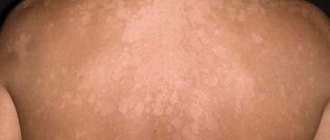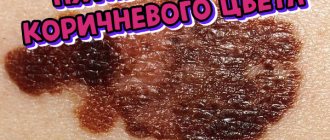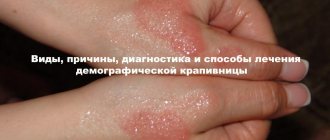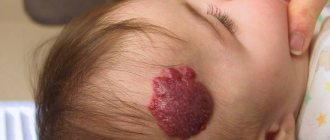(1 ratings, average: 5,00 out of 5)
Home » Problems 18+
Red spots in the groin are a common cause of concern for men and women. Typically, the inflamed areas of the skin are itchy, itchy and painful. Their appearance is explained by a whole range of possible reasons - from insufficient hygiene to systemic pathologies of the body.
general information
Changes in skin color in the groin occur under the influence of external and internal factors. The resulting spots vary in color and size. The strip of inguinal folds is an ideal place for the growth of bacteria, fungi and pathogenic organisms. Often, the epidermis changes color due to a fungus, the proliferation of which causes the destruction of melanin skin cells. More often, irritation appears in the summer. The affected area is increasing rapidly. If a spot appears in an intimate place, you should consult a doctor to determine the cause of pigmentation and begin therapy.
Characteristic symptoms
The most typical place where red spots from fungal infections are most often localized is the area of the inguinal folds or the scrotum. Initially, darkening of the skin occurs in the groin, later the pathology spreads, red spots appear on the stomach, they cover the inner thighs to the pits under the knees, sometimes reaching the chest. There are advanced situations when epidermophytosis practically covers the entire skin surface, affecting even the scalp.
For men, it is not uncommon for a fungus to initially appear on the scrotum. The pathology in this case is often weakly expressed, which is why it remains difficult to notice. Only later does the disease spread to the groin area, and then further along the thighs and abdomen. Among men, simultaneous fungal infection of the groin and feet becomes quite common.
The symptoms of epidermophytosis are clearly expressed:
- Round spots appear that are clearly defined.
- Their color depends on the stage of spread of the pathology (starting from a pale pink tone and ending with a brown-brown tint).
- The spots rise slightly above the skin surface.
- Gradually they grow along the periphery, tending to merge with each other. The spots form an intricate patterned pattern - this is a distinctive sign of a fungal infection.
- Along the edges of the spots there are rashes of different sizes and shapes. At the same time, bubbles and cracks, pustules and erosions, and scales may be present (a clear sign that the bubble is healing). At the same time, the bubbles in the center of the spot begin to heal, appearing again on the periphery. Such polymorphism of parts of the rash helps to differentiate epidermophytosis and other fungal infections.
- Infected areas can itch very much (causing painful itching), bursting blisters begin to smell unpleasant, causing additional discomfort to the patient. Unbearable itching leads to the man scratching the blisters, which then easily become infected and complicate the course of the disease. Moisture appears at the site of scratching and ulcers appear.
- Gradually, the spot begins to regress, it loses the intensity of its color, begins to peel off and becomes brown.
Dermatologists believe that dry polymorphic spots are a sign of typical epidermophytosis, but when pyococcal or candida flora joins it, inflammation occurs and the lesions become wet. Without timely treatment, such a pathology lasts for years, acquiring the character of a chronic disease.
Causes of brown spots in the groin
Fungi, infections, hormonal imbalance, and inflammation can provoke the growth of brown spots in the groin.
- Fungi. Areas of the skin hidden from sunlight and with constant humidity are the best place for fungal activity. Melanins - skin cells that affect its color, are destroyed by fungi. Fungi of the genus Candida are the cause of brown skin in the groin area. Tight, synthetic clothing and insufficient hygiene provoke the growth of fungi. Active reproduction of pathogenic organisms provokes an increase in brown pigmentation in the perineum.
- Violation of the integrity of the skin. The cause of irritation in the groin in women is shaving and hair removal. Wearing tight underwear also provokes a violation of the integrity of the skin in the groin, which contributes to the formation of chafing.
- Inflammatory processes on the external genital organs. The resulting inflammation leads to disruption of melanin production, which causes brown skin in the groin. This type of spot is post-traumatic pigmentation.
- Infectious diseases. The bacteria that cause the infection feed on healthy epidermal cells, the destruction of which leads to pigmentation.
- Hormonal disbalance. Improper functioning of the ovaries or taking hormonal contraceptives provokes increased pigmentation. Often occurs during puberty in adolescents.
- Chemical poisoning. The entry of chemicals into the body causes a disruption of melanogenesis, which leads to the appearance of brown pigmentation in the groin.
- Chronic diseases of the liver, gall bladder and gastrointestinal tract.
- Oncological diseases.
- Addison's disease, which is associated with disruption of the adrenal glands that produce hormones.
Erythrasma
Erythrasma belongs to pseudomycosis and is characterized by a chronic course. The cause of the appearance is pathogenic bacteria. Pathology causes changes in the skin in areas of large folds. Erythrasma is a skin irritation of a bright red hue, although sometimes it turns yellow, brown and even gray-brown. The pathology is accompanied by constant itching and peeling. Diagnosis is carried out by visual examination using fluorescent light. The disease is contagious and is transmitted through skin-to-skin contact or through the patient’s underwear. Erythrasma most often affects men and has a long treatment period. Differential diagnosis of mycosis, pityriasis versicolor, and epidermophytosis is required.
Athlete's foot
Athlete's foot is a fungal infection of the skin in an intimate place. It affects the inguinal and intergluteal folds and the armpit area. In rare cases, it appears on the hands, feet and periungual space. The main route of transmission of the disease is through bodily contact with an infected person, through household items and clothing. They also become infected when visiting public places - baths, saunas, swimming pools and gyms. Accompanying the lesion are excess weight, hyperhidrosis and skin injuries.
The causative agent of the pathology is a fungus that causes the appearance of red or pink spots in the groin. The spot is characterized by clear boundaries, ranging in size from 1 to 10 centimeters and even more. The formation of pigmentation is accompanied by peeling, severe itching and pain in the groin when walking. At the border of the spot, a stripe of rash in the form of transparent bubbles with liquid is visible. Over time, the focal redness disappears and the brown pigmentation takes on the appearance of a ring. Such age spots between the legs are more common in adult men, less common in adolescents.
Tinea versicolor in men and women
Tinea versicolor is a common cause of skin changes in the groin. Ringworm is a fungal disease that in 85% of cases is the reason why brown dark spots appear in the groin in men and in the intimate area in women. The pathogen quickly damages the stratum corneum of the skin. Prolonged exposure to the sun in the heat provokes the disease. The incubation period sometimes reaches 3 months, after which active reproduction occurs. Ringworm versicolor appears as brown pigmented spots in the groin of men and women, the size of which reaches 12 cm. Small brown spots often merge into single areas or stripes. Usually it does not cause any symptoms other than pigmentation, so a person is not aware of the problem for a long time.
Redness precedes the growth of brown spots in the groin area.
Allergic contact dermatitis
An inflammatory skin disease that occurs at the site of direct contact with an allergen. External manifestations become noticeable after regular contact with the substance for a long time.
On the hips, this form of dermatitis occurs due to irritation with synthetic fabrics, as well as with the constant use of aggressive detergents. At the beginning of the disease, the skin of the thighs turns red and swells, then a rash appears in the groin and nodular formations gradually fill with fluid. After opening, erosions remain on the surface, which, when healed, form a crust. Allergic contact dermatitis is characterized by a clearly defined boundary of the affected area that coincides with the area of contact with the irritating substance.
Symptoms
The primary manifestations of infection are redness in the intimate area, on the buttocks and thighs. Round spots appear in different shades of red, brown and yellow. Pimples and severe rashes form along the perimeter of the spot, accompanied by itching and swelling. Some time after its appearance, the focal redness disappears, but a stripe of rash remains along the contour, giving the pathology the appearance of a ring. The rash is accompanied by:
- unpleasant odor;
- formation of abscesses;
- moist skin;
- severe, prolonged itching;
- hyperpigmentation of the epidermis;
- discomfort when walking.
Development mechanism and types
Special substances – pigments – are responsible for the color of human skin. Normally, the body produces them in sufficient quantities, due to which the epidermal integument acquires one shade or another. The main role here is played by the pigment melanin.
If for one reason or another (which were described earlier) its concentration in the cells is disrupted, it begins to accumulate in them, gradually changing the color of the area of the skin where the pathological process occurs. This is how pigment spots form on intimate places.
Hyperpigmentation can be different, but often only 2 types are found in the groin area. What these types are, and how they differ from each other, men and women who are faced with this problem should know. To understand what exactly a person is dealing with in each specific situation, you need to know how to distinguish these types of age spots from each other:
Birthmarks. Moles, or nevi, as they are also called, are spots or bumps on the skin that are black, reddish or brown in color. They can affect different parts of the body, including intimate areas. Such pigmentation can be either congenital or acquired, that is, it can occur throughout a person’s life. This compaction forms gradually. First, a brown spot appears on the surface of the epidermis, which can have different sizes. As a rule, at first it is flat, but over time it can rise slightly above the skin. Despite the fact that genital moles are benign in nature, under the influence of UV rays they can become malignant.
In men, this type of pigmentation usually affects the scrotum, pubis and folds of skin near intimate places. In women, the labia and inner thighs are affected. If the nevus is constantly injured due to friction with clothing, it is recommended to remove it
Moles can disappear on their own over time, so it is not always necessary to fight them. Important! If you notice that genital moles have changed shape or color, or have begun to bother you and cause pain, contact a dermatologist immediately! Such alarming symptoms may indicate the development of melanoma - skin cancer.
Chloasma. The inner and outer sides of the thighs, as well as the area of skin close to the external genitalia, suffer most from this type of pigmentation.
Chloasma often occurs in pregnant women, as well as in girls who often take hormonal contraceptives. In men, such age spots in the groin appear due to liver diseases (especially hepatitis and cirrhosis).
What type of pigmentation occurs in each individual case can only be determined by a doctor after diagnosis. If spots cause discomfort, it is better to get rid of them immediately, without waiting for them to spread to other areas of the skin.
How to get rid of stains?
To select an adequate treatment for brown spots in the groin, you need to find out their root cause with your doctor.
Before you learn how to get rid of brown pigmentation on the skin in the groin, the cause of the occurrence is determined. Without eliminating the cause, irritations will continue to appear. If the appearance of pigmentation is associated with injury, then brown skin can remain for life; the normal shade of the affected skin area can be restored with the help of laser correction. When the cause is systemic or oncological diseases, then first you need to cure them. By eliminating the root cause of the pathology, self-removal of the stain is possible. If the appearance of pigmentation is associated with the introduction of a fungus, then treatment is prescribed using systemic and local antifungal agents:
- "Nitrofugin";
- "Mikoseptin";
- "Clotrimazole";
- "Dermozolon";
- "Nizoral";
- tablets "Terbinafil" and "Orunit";
- Triderm ointment.
Therapy continues from 1 month or longer, depending on the course of the disease and the condition of the skin. Treating the epidermis with a 2% alcohol iodine solution or an antiseptic solution prevents the disease from returning. The treatment complex includes taking immunostimulating drugs. It is not recommended to treat the fungus on your own; the course of treatment is prescribed by a doctor after diagnosis and determination of the root cause. If after treatment the skin at the site of the lesion does not return to its previous shade, cosmetic methods of skin lightening using laser and peeling are used.
Calluses on the buttocks: quickly and effectively treated at home
Everyone in their life, sooner or later, faces such a problem as calluses. They appear on the toes after wearing tight shoes, on the hands - from heavy physical exertion or intense “writing”. But few people know that there are so-called gluteal calluses, which appear in the form of dark, rough, often rough spots located in the area of the ischium. Well, have you found out your problem? Then let's fight ugly dark calluses on the butt together!
What are gluteal calluses and what causes them?
Calluses on the buttocks are not that uncommon. They are two symmetrical dark brown or dark pink spots located simultaneously on both buttocks. Typically, the skin in these areas is rougher, rougher, and darker. They do not cause any pain, discomfort, do not itch or itch. Their only drawback is aesthetics, or rather the lack thereof, because it’s a shame to show such a “calloused” butt, especially to go to the beach with it, go to the sauna, etc.
The main cause of calluses on the butt is constant friction of the skin against any hard, uncomfortable objects, such as a chair. If you constantly sit on a wooden or plastic hard seat, then, unfortunately, you can practically avoid the appearance of calluses.
We have figured out why “labor” calluses on the butt occur, now it’s time to start removing/treating them. To get rid of dark spots on your butt, you just need to follow three simple rules. But we must remember that the effectiveness of such recipes will be high only if the necessary procedures are carried out regularly.
Treating calluses on the buttocks at home
We should not forget that, at their core, calluses on the butt are just rough, thick and dry skin that very actively needs hydration and nutrition. This is what the course of treatment for calluses will be based on.
To remove gluteal calluses , it is recommended to perform the following procedures: Read on
Prevention
Personal hygiene and a healthy lifestyle will help prevent the growth of brown spots in the groin.
- wear underwear made from natural materials and change it on time;
- refuse clothes that are too tight;
- monitor intimate hygiene;
- be careful when visiting public places;
- do not use other people’s shaving products, bed linen or underwear;
- after visiting the pool, sauna or bathhouse, treat the intimate area and armpits with an antiseptic solution (“Chlorhexidine” or “Miramistin”).
To prevent skin problems from occurring, avoid excessive sweating and trauma to the skin of the intimate area. For many, brown spots in the perineum cause emotional problems and a feeling of embarrassment, which is why a person puts off visiting a doctor. The longer the disease progresses, the longer it takes to treat pigmentation. Therefore, if suspicious changes in skin color appear in the groin, it is better to immediately consult a dermatologist.
Ringworm (colored, pink)
One of the most common diseases that results in the formation of spots on the surface of the skin is lichen. There are many varieties of this disease, including pink (Gibera) and pityriasis versicolor (pityriasis versicolor). It can affect any area of the skin, and the groin area is no exception in this case. All species have similar external characteristics, but the mechanism of their formation is different. It is impossible to independently distinguish one from the other; professional diagnosis and examination by a doctor are necessary.
Tinea versicolor requires strict adherence to the treatment regimen. Therapy includes antifungals and antihistamines. It is necessary to submit a scraping from the damaged area of skin for analysis every week. Based on the results obtained, the attending physician makes changes to the original regimen until the disease is completely cured. Pityriasis rosea, according to some doctors, does not require treatment at all and goes away on its own after some time.
It must be emphasized that lichen in the groin in men, like the vast majority of other diseases of a similar nature, occurs due to increased sweating in this area. Therefore, as a preventive measure, you should carefully monitor personal hygiene, without getting carried away with it, however, so as not to upset the skin balance. Avoid synthetic underwear and various skin injuries. Good functioning of the immune system and the absence of severe stress are also of great importance. To avoid erroneous actions, if spots appear in the groin, you should consult a dermatologist.
Red spots on the inner thigh in men: photos, causes, treatment
Brown spots in the groin in men: photos, causes, treatment
The spots that appear in the groin area cause discomfort and inconvenience in both men and women. Brown spots in the groin cause pain and swelling. Sometimes hyperpigmentation does not cause any symptoms and a person discovers the spots by chance. Brown pigmentation is formed under the influence of various factors, including the influence of inflammatory processes in the body. Pigmentation cannot be ignored, and if detected, it is better to consult a dermatologist for advice.
The appearance of brown spots in the groin is usually a sure sign of a fungal skin disease.
Diseases manifested by spots in the groin area
The appearance of a brown or red spot in the groin in men is a symptom of a pathological process in the body. The main diseases that are manifested by the formation of spots on human skin:
- Addison's disease.
- Erythrasma.
- Versicolor and pink lichen.
- Tumor neoplasms of internal organs.
- Inguinal athlete's foot.
The causes of darkening of the skin in intimate places are varied. It is necessary to worry in cases where, in addition to spots, other alarming symptoms are observed - itching, burning, swelling, weeping, etc.
Addison's pathology
This disease is caused by hormonal imbalance in the human body. In particular, there is a disruption in the synthesis of cortisol, as the adrenal glands do not work properly. Over time, the functioning of all internal organs is disrupted. Clinic: darkening of the nipples, the appearance of red spots in the armpits, skin pigmentation in the groin. The disease is very rare, approximately one case in a hundred thousand. Girls are predominantly affected, although men are also not immune from the development of an abnormal process in the body.
Tumors of internal organs
If a malignant tumor has appeared in the stomach, it often appears on the skin of men. Brown spots of different shapes and sizes appear. They do not itch, however, they are velvety and dense to the touch. To establish an accurate diagnosis, it is recommended to immediately consult a doctor. In women, against the background of tumors in the stomach, spots between the legs rarely appear, the disease is more often accompanied by general malaise, painful sensations and other clinical manifestations.
Erythrasma
The disease develops due to the penetration of fungi and bacteria. Characterized by exacerbations and short-term remissions. Predisposing factors:
- Obesity (some doctors agree that this disease is exclusive to obese patients);
- Increased sweating;
- Failure to comply with basic hygiene rules;
- Professional activities related to work with high temperatures;
- Work that requires constant exposure to rooms with high humidity (swimming pools, saunas, etc.).
Sometimes the spots are localized on the inner thighs, in the armpits, under the mammary glands (in women), near the navel (as in the photo), in the area of the abdominal folds, near the scrotum (in men). At an early stage of development, red spots in the groin area are small in size - up to about 2 cm. As the disease progresses, they tend to increase several times. When the form is advanced, it is accompanied by large lesions of the skin.
Tinea versicolor
The causative agent is a yeast-like fungus that actively multiplies in the stratum corneum of the skin. As a rule, this species is classified as opportunistic microorganisms, since it is present on the skin of all people in small quantities. In the presence of favorable factors, an increase in pathogenic flora is observed. The etiology is due to a sharp deterioration in the functioning of the immune system and the presence of chronic pathologies.
Darkening of the skin in the groin is observed, the spots have different sizes, sometimes uneven coloring, the boundaries are clear or blurry. Some clinical pictures include itching and burning.
Athlete's foot
The pathology is classified as dermatological diseases, which are provoked by the active proliferation of fungi. The most common location is the femoral and groin area. First, small spots of a light brown hue appear, their size is no more than one centimeter. Over time, they transform into large spots with a clear red border, increase in size, and migrate throughout the body.
Rubromycosis
A fungal disease that usually affects the feet and toenails. In the generalized form, the lesions are localized in the inguinal and gluteal folds. People who sweat heavily and are overweight are at risk. With this pathology, the spots appear as if from the lower layers of the skin. A powdery peeling appears on their surface, and a bright convex border appears around the formations. In some cases, suppuration occurs. Therapy involves the use of antifungal agents for local and internal use. Treatment is long, sometimes lasting for six months.











